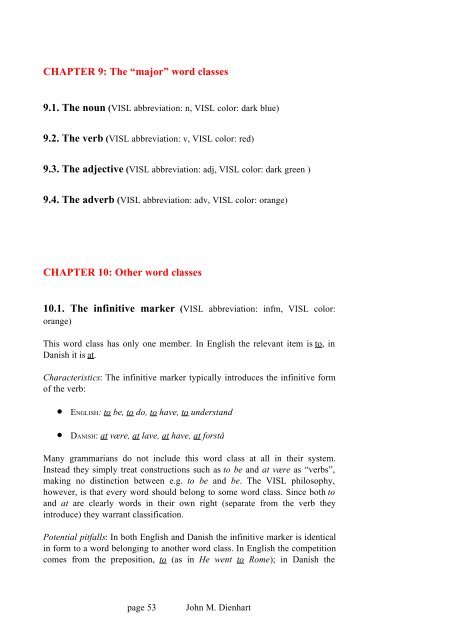Download - VISL
Download - VISL
Download - VISL
You also want an ePaper? Increase the reach of your titles
YUMPU automatically turns print PDFs into web optimized ePapers that Google loves.
CHAPTER 9: The “major” word classes<br />
9.1. The noun (<strong>VISL</strong> abbreviation: n, <strong>VISL</strong> color: dark blue)<br />
9.2. The verb (<strong>VISL</strong> abbreviation: v, <strong>VISL</strong> color: red)<br />
9.3. The adjective (<strong>VISL</strong> abbreviation: adj, <strong>VISL</strong> color: dark green )<br />
9.4. The adverb (<strong>VISL</strong> abbreviation: adv, <strong>VISL</strong> color: orange)<br />
CHAPTER 10: Other word classes<br />
10.1. The infinitive marker (<strong>VISL</strong> abbreviation: infm, <strong>VISL</strong> color:<br />
orange)<br />
This word class has only one member. In English the relevant item is to, in<br />
Danish it is at.<br />
Characteristics: The infinitive marker typically introduces the infinitive form<br />
of the verb:<br />
• ENGLISH: to be, to do, to have, to understand<br />
• DANISH: at være, at lave, at have, at forstå<br />
Many grammarians do not include this word class at all in their system.<br />
Instead they simply treat constructions such as to be and at være as “verbs”,<br />
making no distinction between e.g. to be and be. The <strong>VISL</strong> philosophy,<br />
however, is that every word should belong to some word class. Since both to<br />
and at are clearly words in their own right (separate from the verb they<br />
introduce) they warrant classification.<br />
Potential pitfalls: In both English and Danish the infinitive marker is identical<br />
in form to a word belonging to another word class. In English the competition<br />
comes from the preposition, to (as in He went to Rome); in Danish the<br />
page 53<br />
John M. Dienhart
















